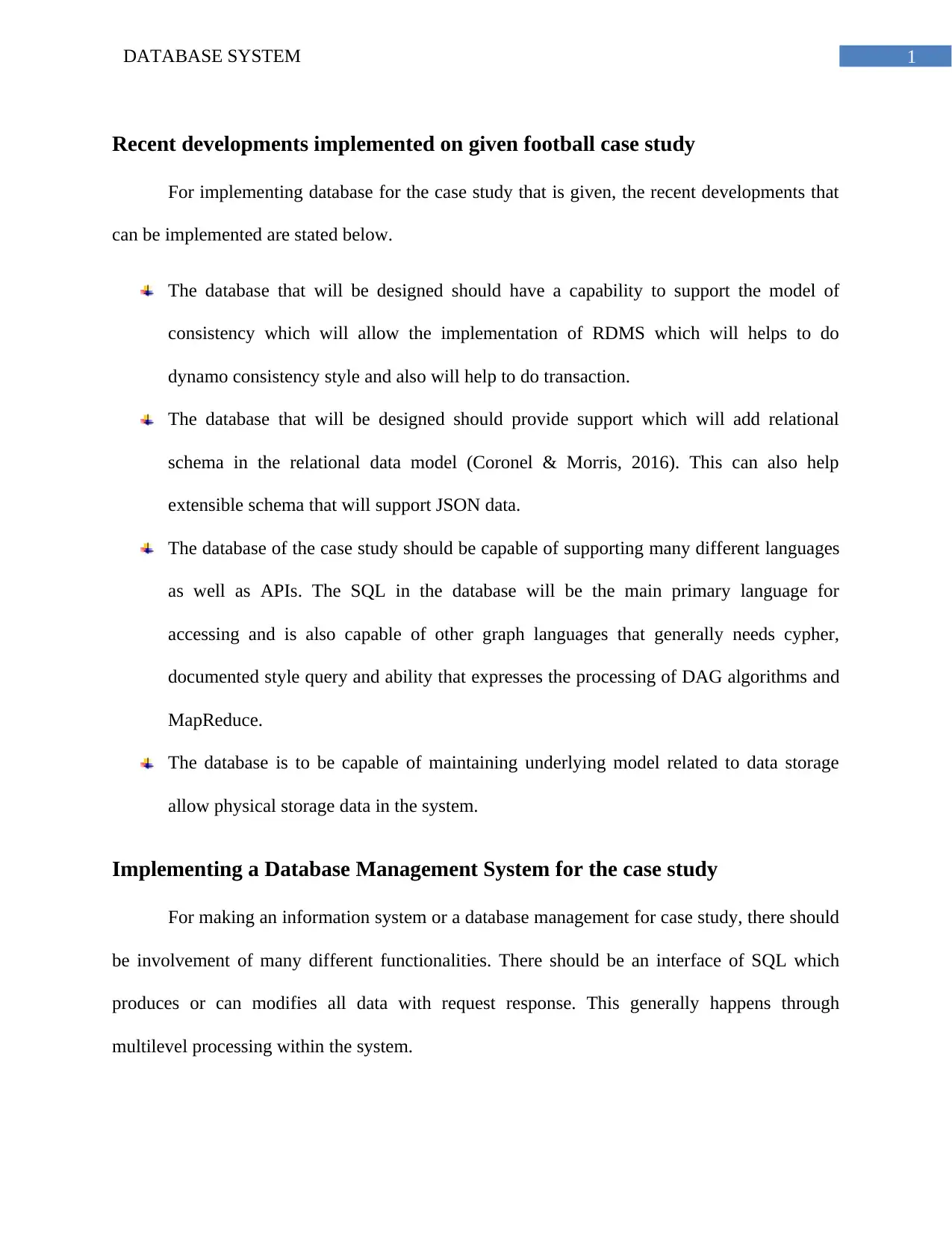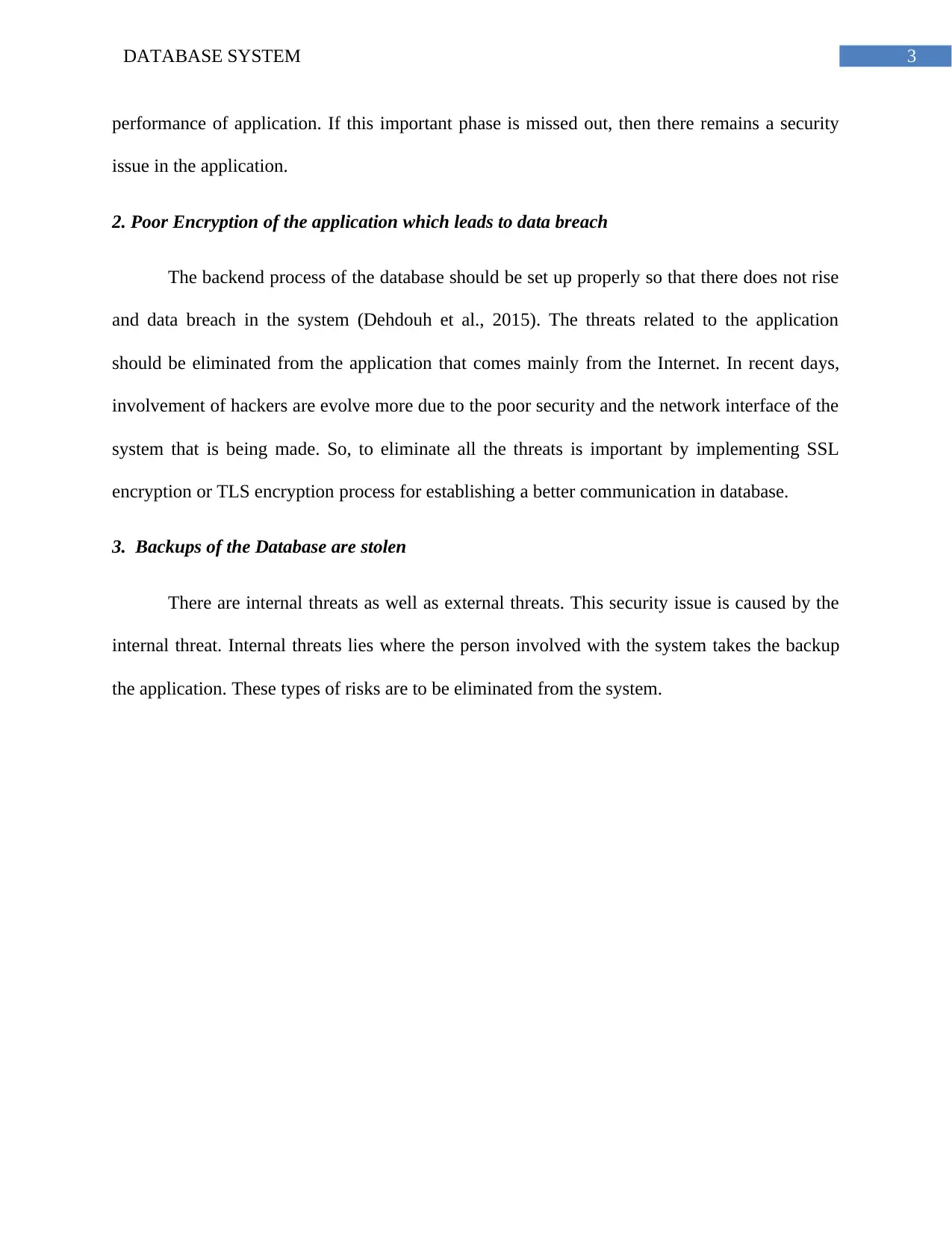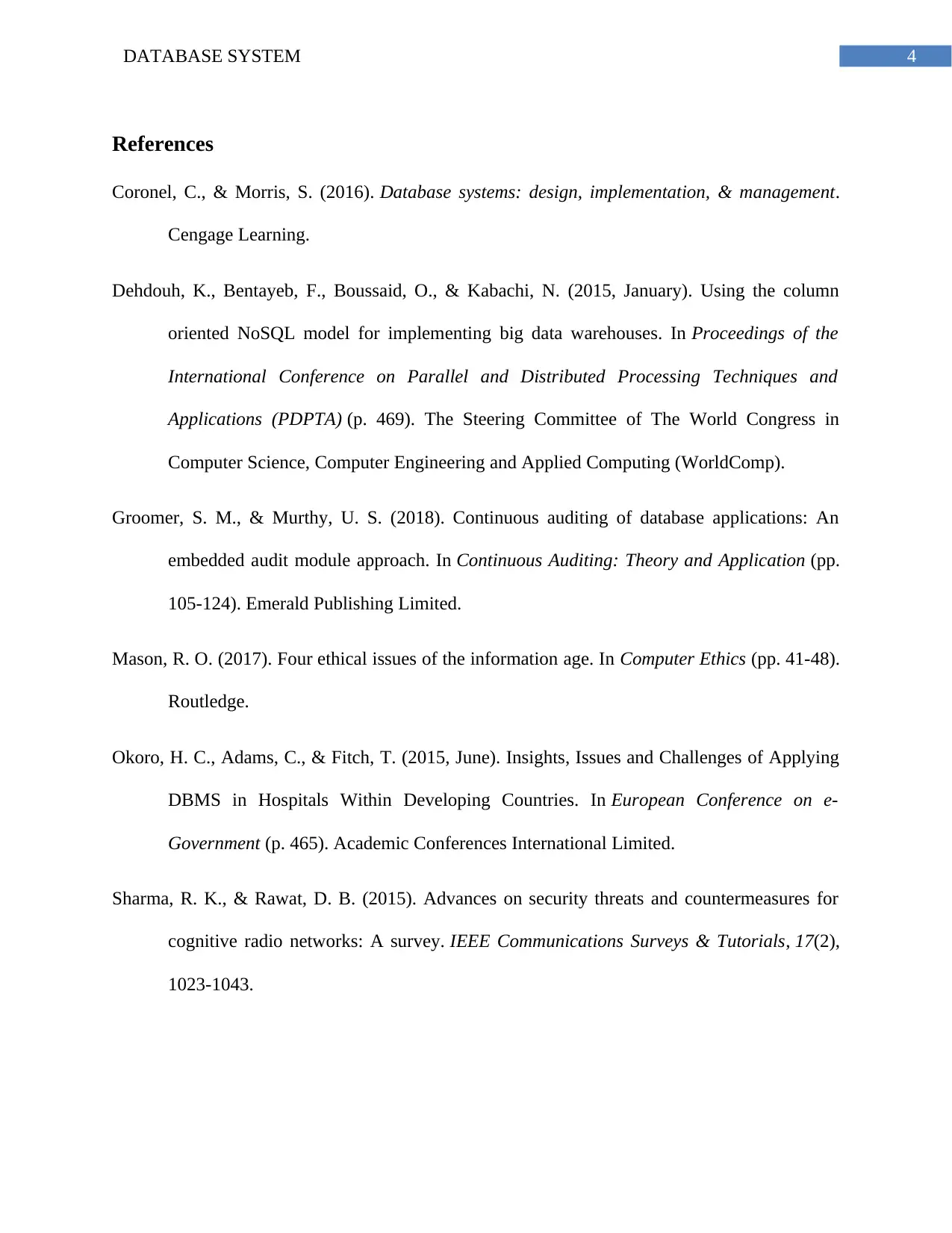Database System: Cloud Implementation, Recent Trends, Security Issues
VerifiedAdded on 2023/06/04
|5
|1072
|208
Report
AI Summary
This report delves into the recent advancements in database technology, particularly focusing on the implementation of a web database in a cloud instance, drawing from a football case study. It emphasizes the importance of a database design capable of supporting consistency models, RDBMS implementation, and transactional capabilities. The report highlights the need for relational schema support, extensible schema for JSON data, and multilingual API compatibility, with SQL as the primary access language alongside graph languages. It also addresses critical security issues such as inadequate testing before deployment, poor encryption leading to data breaches, and the risk of stolen database backups, recommending measures like SSL/TLS encryption to enhance communication security and mitigate internal and external threats. The discussion includes considerations for user authentication, Oracle integration, and MySQL table management, ensuring a robust and secure database environment.

Running head: DATABASE SYSTEM
Database System
Name of Student-
Name of University-
Author’s Note-
Database System
Name of Student-
Name of University-
Author’s Note-
Paraphrase This Document
Need a fresh take? Get an instant paraphrase of this document with our AI Paraphraser

1DATABASE SYSTEM
Recent developments implemented on given football case study
For implementing database for the case study that is given, the recent developments that
can be implemented are stated below.
The database that will be designed should have a capability to support the model of
consistency which will allow the implementation of RDMS which will helps to do
dynamo consistency style and also will help to do transaction.
The database that will be designed should provide support which will add relational
schema in the relational data model (Coronel & Morris, 2016). This can also help
extensible schema that will support JSON data.
The database of the case study should be capable of supporting many different languages
as well as APIs. The SQL in the database will be the main primary language for
accessing and is also capable of other graph languages that generally needs cypher,
documented style query and ability that expresses the processing of DAG algorithms and
MapReduce.
The database is to be capable of maintaining underlying model related to data storage
allow physical storage data in the system.
Implementing a Database Management System for the case study
For making an information system or a database management for case study, there should
be involvement of many different functionalities. There should be an interface of SQL which
produces or can modifies all data with request response. This generally happens through
multilevel processing within the system.
Recent developments implemented on given football case study
For implementing database for the case study that is given, the recent developments that
can be implemented are stated below.
The database that will be designed should have a capability to support the model of
consistency which will allow the implementation of RDMS which will helps to do
dynamo consistency style and also will help to do transaction.
The database that will be designed should provide support which will add relational
schema in the relational data model (Coronel & Morris, 2016). This can also help
extensible schema that will support JSON data.
The database of the case study should be capable of supporting many different languages
as well as APIs. The SQL in the database will be the main primary language for
accessing and is also capable of other graph languages that generally needs cypher,
documented style query and ability that expresses the processing of DAG algorithms and
MapReduce.
The database is to be capable of maintaining underlying model related to data storage
allow physical storage data in the system.
Implementing a Database Management System for the case study
For making an information system or a database management for case study, there should
be involvement of many different functionalities. There should be an interface of SQL which
produces or can modifies all data with request response. This generally happens through
multilevel processing within the system.

2DATABASE SYSTEM
At the time of implementing the database, the users in the database system should possess
a proper appropriate login details for signing in to the system. On adding the oracle in the
system, proper names is to be provided in the oracle platform (Sharma & Rawat, 2015). This will
allow the Oracle DBMS to run in different database which are isolated from each other.
When the use is done with the process of providing username and password, then the user
will have to place the MySQL in proper table that are provided in the database (Groomer &
Murthy, 2018). The space for providing the name should be kept independent and the space for
table and username should be kept synonymous. The username is different from each other and
there are different database that serves in different purpose.
After making the table space, there are different number of tables that are usually visible.
There are columns which are visible in each table. Tables are taken from different table space
and can be accessed (Mason, 2017). The main concept of MYSQL is very much depended on the
table space and there is same concept for the database also. But the case is different in Oracle.
Two tables in Oracle are different from each other. Other syntax are same in both the cases.
Security issues related to the Database
There are many common issues related to security while developing database. The
common security issues that are related to the database are stated below.
1. No Testing is done before deploying the application
This is one of the main issue that the applications faces. The applications are deployed
before completing the testing phase (Okoro, Adams & Fitch, 2015). This is a negligence in the
deployment stage of the application development. The testing is done mainly to check the
At the time of implementing the database, the users in the database system should possess
a proper appropriate login details for signing in to the system. On adding the oracle in the
system, proper names is to be provided in the oracle platform (Sharma & Rawat, 2015). This will
allow the Oracle DBMS to run in different database which are isolated from each other.
When the use is done with the process of providing username and password, then the user
will have to place the MySQL in proper table that are provided in the database (Groomer &
Murthy, 2018). The space for providing the name should be kept independent and the space for
table and username should be kept synonymous. The username is different from each other and
there are different database that serves in different purpose.
After making the table space, there are different number of tables that are usually visible.
There are columns which are visible in each table. Tables are taken from different table space
and can be accessed (Mason, 2017). The main concept of MYSQL is very much depended on the
table space and there is same concept for the database also. But the case is different in Oracle.
Two tables in Oracle are different from each other. Other syntax are same in both the cases.
Security issues related to the Database
There are many common issues related to security while developing database. The
common security issues that are related to the database are stated below.
1. No Testing is done before deploying the application
This is one of the main issue that the applications faces. The applications are deployed
before completing the testing phase (Okoro, Adams & Fitch, 2015). This is a negligence in the
deployment stage of the application development. The testing is done mainly to check the
⊘ This is a preview!⊘
Do you want full access?
Subscribe today to unlock all pages.

Trusted by 1+ million students worldwide

3DATABASE SYSTEM
performance of application. If this important phase is missed out, then there remains a security
issue in the application.
2. Poor Encryption of the application which leads to data breach
The backend process of the database should be set up properly so that there does not rise
and data breach in the system (Dehdouh et al., 2015). The threats related to the application
should be eliminated from the application that comes mainly from the Internet. In recent days,
involvement of hackers are evolve more due to the poor security and the network interface of the
system that is being made. So, to eliminate all the threats is important by implementing SSL
encryption or TLS encryption process for establishing a better communication in database.
3. Backups of the Database are stolen
There are internal threats as well as external threats. This security issue is caused by the
internal threat. Internal threats lies where the person involved with the system takes the backup
the application. These types of risks are to be eliminated from the system.
performance of application. If this important phase is missed out, then there remains a security
issue in the application.
2. Poor Encryption of the application which leads to data breach
The backend process of the database should be set up properly so that there does not rise
and data breach in the system (Dehdouh et al., 2015). The threats related to the application
should be eliminated from the application that comes mainly from the Internet. In recent days,
involvement of hackers are evolve more due to the poor security and the network interface of the
system that is being made. So, to eliminate all the threats is important by implementing SSL
encryption or TLS encryption process for establishing a better communication in database.
3. Backups of the Database are stolen
There are internal threats as well as external threats. This security issue is caused by the
internal threat. Internal threats lies where the person involved with the system takes the backup
the application. These types of risks are to be eliminated from the system.
Paraphrase This Document
Need a fresh take? Get an instant paraphrase of this document with our AI Paraphraser

4DATABASE SYSTEM
References
Coronel, C., & Morris, S. (2016). Database systems: design, implementation, & management.
Cengage Learning.
Dehdouh, K., Bentayeb, F., Boussaid, O., & Kabachi, N. (2015, January). Using the column
oriented NoSQL model for implementing big data warehouses. In Proceedings of the
International Conference on Parallel and Distributed Processing Techniques and
Applications (PDPTA) (p. 469). The Steering Committee of The World Congress in
Computer Science, Computer Engineering and Applied Computing (WorldComp).
Groomer, S. M., & Murthy, U. S. (2018). Continuous auditing of database applications: An
embedded audit module approach. In Continuous Auditing: Theory and Application (pp.
105-124). Emerald Publishing Limited.
Mason, R. O. (2017). Four ethical issues of the information age. In Computer Ethics (pp. 41-48).
Routledge.
Okoro, H. C., Adams, C., & Fitch, T. (2015, June). Insights, Issues and Challenges of Applying
DBMS in Hospitals Within Developing Countries. In European Conference on e-
Government (p. 465). Academic Conferences International Limited.
Sharma, R. K., & Rawat, D. B. (2015). Advances on security threats and countermeasures for
cognitive radio networks: A survey. IEEE Communications Surveys & Tutorials, 17(2),
1023-1043.
References
Coronel, C., & Morris, S. (2016). Database systems: design, implementation, & management.
Cengage Learning.
Dehdouh, K., Bentayeb, F., Boussaid, O., & Kabachi, N. (2015, January). Using the column
oriented NoSQL model for implementing big data warehouses. In Proceedings of the
International Conference on Parallel and Distributed Processing Techniques and
Applications (PDPTA) (p. 469). The Steering Committee of The World Congress in
Computer Science, Computer Engineering and Applied Computing (WorldComp).
Groomer, S. M., & Murthy, U. S. (2018). Continuous auditing of database applications: An
embedded audit module approach. In Continuous Auditing: Theory and Application (pp.
105-124). Emerald Publishing Limited.
Mason, R. O. (2017). Four ethical issues of the information age. In Computer Ethics (pp. 41-48).
Routledge.
Okoro, H. C., Adams, C., & Fitch, T. (2015, June). Insights, Issues and Challenges of Applying
DBMS in Hospitals Within Developing Countries. In European Conference on e-
Government (p. 465). Academic Conferences International Limited.
Sharma, R. K., & Rawat, D. B. (2015). Advances on security threats and countermeasures for
cognitive radio networks: A survey. IEEE Communications Surveys & Tutorials, 17(2),
1023-1043.
1 out of 5
Related Documents
Your All-in-One AI-Powered Toolkit for Academic Success.
+13062052269
info@desklib.com
Available 24*7 on WhatsApp / Email
![[object Object]](/_next/static/media/star-bottom.7253800d.svg)
Unlock your academic potential
Copyright © 2020–2025 A2Z Services. All Rights Reserved. Developed and managed by ZUCOL.





